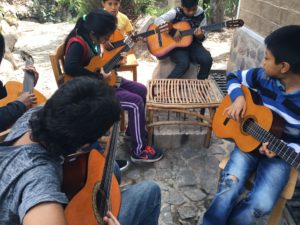The importance of music in the classroom

“There is no complete spiritual life without music, for the human soul has regions which can be illuminated only by music.” Zoltan Kondaly.
In 1951, Zoltán Kodaly (Kecskemét, 1882 – Budapest, 1967), Hungarian researcher and musical composer who introduced Hungarian schools to the music lessons period ampliation into a complete hour daily. Results were amazing, having an overall performance increase compared with the rest of the region’s schools; a remarkable point is that in order to dedicate a complete hour to music the rest of the lessons had their period’s time shortened.
Music influences in a great way the sensitivity development, creativity, discipline, and the human’s social behavior; These can be seen holistically reflected on the self’s development.
In Escuela Caracol, music is a basic tool used to holistically nurture our Caracolitos and Caracolitas. It begins during the first septennium (ages 0 – 7) with singing until reaching the melodic instruments such as the flute or the guitar during the second septennium (ages 7-14).
Students show such happiness every time they master any task related to this subject, such as tuning the guitar or interpreting a whole song, beyond that, its wonderful to see the way they share their achievements instead of falling into competitive or comparative conducts.
Once you know this, it’s no hard to understand why Escuela Caracol is the place where children are happy.
Become part of our community and help us continue nurturing Mayan children from the western region of Lake Atitlán; share our posts and newsletter with your friends and family, speak about Escuela Caracol with your workmates, sponsor a student, or make a one-time donation.
Click the link to donate https://escuelacaracol.org/make-a-one-time-donation/
